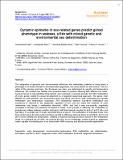Por favor, use este identificador para citar o enlazar a este item:
http://hdl.handle.net/10261/174654COMPARTIR / EXPORTAR:
 SHARE SHARE
 CORE
BASE CORE
BASE
|
|
| Visualizar otros formatos: MARC | Dublin Core | RDF | ORE | MODS | METS | DIDL | DATACITE | |

| Título: | Dynamic epimarks in sex-related genes predict gonad phenotype in the European sea bass, a fish with mixed genetic and environmental sex determination |
Autor: | Anastasiadi, Dafni CSIC ORCID; Vandeputte, Marc; Sánchez Baizán, Núria CSIC ORCID ; Piferrer, Francesc CSIC ORCID | Palabras clave: | Epigenetic inheritance Early development Dnvironmental temperature DNA methylation Sex determination Aromatase cyp19a1a dmrt1 DNA methylation threshold Epigenetic marks |
Fecha de publicación: | oct-2018 | Editor: | Taylor & Francis | Citación: | Epigenetics 13(9): 988-1011 (2018) | Resumen: | The integration of genomic and environmental influences into methylation patterns to bring about a phenotype is of central interest in developmental epigenetics, but many details are still unclear. The sex ratios of the species used here, the European sea bass, are determined by genetic and temperature influences. We created four families from parents known to produce offspring with different sex ratios, exposed larvae to masculinizing temperatures and examined, in juvenile gonads, the DNA methylation of seven genes related to sexual development by a targeted sequencing approach. The genes most affected by both genetics and environment were cyp19a1a and dmrt1, with contrasting sex-specific methylation and temperature responses. The relationship between cyp19a1a methylation and expression is relevant to the epigenetic regulation of vertebrate sex, and we report the evidence of such relationship only below a methylation threshold, ~ 80%, and that it was sex-specific: negatively correlated in females but positively correlated in males. From parents to offspring, the methylation in gonads was midway between oocytes and sperm, with bias towards oocytes for amh-r2, er-β2, fsh-r and cyp19a1a. In contrast, dmrt1 levels resembled those of sperm. The methylation of individual CpGs from foxl2, er-β2 and nr3c1 were conserved from parents to offspring, whereas those of cyp19a1a, dmrt1 and amh-r2 were affected by temperature. Utilizing a machine-learning procedure based on the methylation levels of a selected set of CpGs, we present the first, to our knowledge, system based on epigenetic marks capable of predicting sex in an animal with ~ 90% accuracy and discuss possible applications | Descripción: | 24 pages, 8 figures, 1 table, supplementary material https://doi.org/10.1080/15592294.2018.1529504 | Versión del editor: | https://doi.org/10.1080/15592294.2018.1529504 | URI: | http://hdl.handle.net/10261/174654 | DOI: | 10.1080/15592294.2018.1529504 | Identificadores: | doi: 10.1080/15592294.2018.1529504 issn: 1559-2294 e-issn: 1559-2308 |
| Aparece en las colecciones: | (ICM) Artículos |
Ficheros en este ítem:
| Fichero | Descripción | Tamaño | Formato | |
|---|---|---|---|---|
| Anastasiadi_et_al_2018_postprint.pdf | 2,99 MB | Adobe PDF |  Visualizar/Abrir |
CORE Recommender
PubMed Central
Citations
17
checked on 13-abr-2024
SCOPUSTM
Citations
53
checked on 23-abr-2024
WEB OF SCIENCETM
Citations
43
checked on 23-feb-2024
Page view(s)
223
checked on 24-abr-2024
Download(s)
111
checked on 24-abr-2024
Google ScholarTM
Check
Altmetric
Altmetric
Artículos relacionados:
NOTA: Los ítems de Digital.CSIC están protegidos por copyright, con todos los derechos reservados, a menos que se indique lo contrario.
